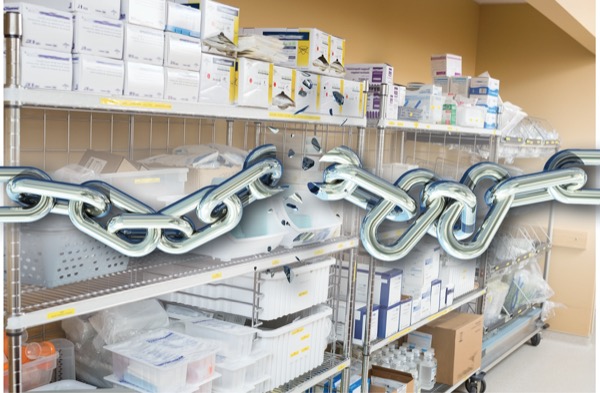SAVANNAH, Ga.—The healthcare industry has been slowly learning to pivot during supply chain disruptions brought on by the COVID-19 pandemic, weather events and other factors over the past couple of years, a speaker said at the 2023 OR Business Management Conference. A strong, proactive supply chain management strategy can help health systems be better prepared going forward.
While many people think of 2020 as the most disruptive year on record regarding the supply chain, 2021 also brought a number of challenges, said Andrew Martin, RN, CPHRM, a patient safety analyst and consultant with ECRI and the Institute for Safe Medication Practices Patient Safety Organization, in Plymouth Meeting, Pa.
Winter storm Uri with its historic cold weather and power outages brought about $195 million in damages, he said. The container ship Ever Given turned sideways in the Suez Canal, blocking traffic in a waterway used for global shipping and leading to a $9.6 billion disruption in commerce. There were also wildfires burning on the West Coast, pirate activity in the Asia Pacific and typhoons in the South China Sea. Then 2022 brought Hurricane Ian and other events.
“We need to keep thinking outside the box and making sure we’re utilizing all the resources that are available to us,” Mr. Martin said. “Supply chain disruption isn’t ending. It’s going to be part of our normal business practice and we need to know how we’re going to address that.”
Health systems can learn from common supply chain disruptions seen in 2020, he noted, such as gaps in day-to-day resources. During the pandemic shutdown, people weren’t going out to harvest raw materials and get them to manufacturers. There were delays in shipping and diversion of some raw materials to other product lines. For example, blue wrapping to sterilize tools was being repurposed to make gowns for personal protective equipment. Some medications went on shortage as everyone competed for the same ones.
Additionally, Mr. Martin said, “the structure of our supply chain was really fragile and not as integrated as we thought.” With pressure to reduce inventory costs, many health systems had been using single-source contracts for supplies, with just-in-time delivery. Consequently, they weren’t able to respond to a surge in patients. Normally hospitals could pull resources from other areas of the country not impacted by a problem, but during the pandemic, hospitals globally were looking for similar products and medications simultaneously, and even some nonmedical industries like hotels were competing for stronger disinfectants. Nontraditional suppliers emerged to help cover some of the gaps, he said.
Causes of supply chain interruptions continue to be numerous, Mr. Martin noted, and they can include natural disasters, transportation failures and delays, problems with products, price fluctuations, and cyberattacks.
The best counterattack is to plan for disruptions, according to Mr. Martin. Think about transparency during purchasing, he said. Learn where products are manufactured and distributed so that in the event of any kind of global unrest or weather event, clinicians may be prepared ahead of time if there’s a potential impact to the supply chain. Maintain a list of key devices and products needed to operate on a daily basis, and conduct a risk assessment on those products if there is something happening that could disrupt the ability to get them. Clinicians should inquire about distributors’ and manufacturers’ capacity, so that it is known if they can handle an increased demand. Additionally, he advised, connect with government agencies to stay on top of potential shortages and alert local legislatures as to how a practice may be affected if a particular product becomes unavailable. Consider partnering with other organizations in the area for group purchasing of certain products under government-funded programs if needed.
Also, reexamine sole-source agreements so that clinicians are not limited to purchasing from one company. “Start thinking about redesigning your contracts. That’s going to give you the flexibility to find different vendors when they’re unable to supply and meet your needs,” Mr. Martin said.
In vetting nontraditional suppliers, make sure they’re not fraudulent and they are providing the materials they promise, Mr. Martin advised. Organizations such as ECRI, SGS (General Society of Surveillance) and the National Institute for Occupational Safety and Health (NIOSH) are independent, third parties that can test products clinicians plan to purchase, helping organizations make informed decisions. Also, clinicians should go to manufacturer websites to see if they look legitimate. Ask potential vendors for references from other healthcare companies they have worked with. Network and develop relationships with other centers in order to potentially have someone to reach out to in case of a supply chain issue to get the materials you need.
Additionally, ask vendors for specific product photos, and look for a domestic tax identification number to ensure there is some recourse if the product does not arrive. Define delivery terms. If one has the time and the need isn’t urgent, ask for samples that can be personally tested or taken to a third party for evaluation. Establish an ongoing testing routine for product quality, either internally or externally, especially for items from nontraditional suppliers. In that way, clinicians can ensure the quality doesn’t change during receipt of additional shipments.
When making product substitutions, Mr. Martin advised, communicate with hospital staff and educate or train them on any differences to be aware of or potential changes in the workflow. Furthermore, he said, know the devices being used during periods of FDA emergency use authorization (EUA) and ensure that when the EUA ends, use of the devices is stopped since they were modified to be allowed to be used.
When operating under an EUA, clinicians should notify patients that the devices being used are covered by an EUA or have a fact sheet available to hand out to patients, staff and providers. Provide education on the proper use of those products and make sure to include them in the hospital credentialing process, or policies and procedures.
Beware of falsified documents from nontraditional suppliers, Mr. Martin said. “No vendor is going to have an authorization letter that comes from the FDA or NIOSH providing them with a certificate of authenticity,” he said. These agencies do not provide such certificates. To confirm a vendor is legitimate, go to the FDA or other agency website and review the approved manufacturers list, verifying the company is listed.
Mr. Martin reported no relevant financial disclosures.


